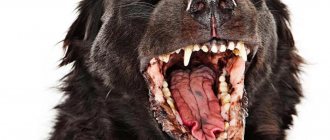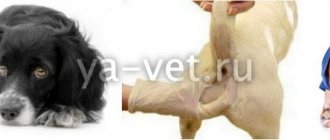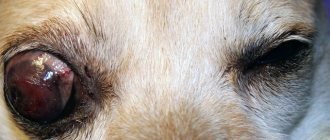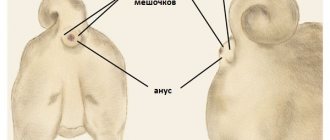Content
1. Causes of pyometra in dogs 2. Main signs of pyometra in dogs 3. About surgical and non-surgical treatment 4. Diagnosis of pyometra in dogs 5. Rehabilitation after surgery 6. Prevention of pyometra in dogs
The endometrium, located in the internal genital organs of mammals of the external sex, is a mucous membrane with a heterogeneous and multilayered structure. Its surface is constantly renewed, which allows it to maintain reproductive function for a long period, as well as to produce healthy offspring. The layers are constantly replaced until adulthood and the end of estrus. During sexual intercourse or lack of normal hygiene, injuries and past illnesses, the endometrium is an ideal place for the proliferation of pathogenic anaerobic bacteria.
The disease called pyometra is nothing more than purulent endometritis. Not only dogs are susceptible to it, but also all mammals that give birth to a large number of young. Susceptibility does not depend on breed, it is only affected by age and the accumulating bacterial environment. Typically, animals aged 5 to 10 years are at risk. Further, the probability decreases significantly.
Prevention methods
To prevent your dog from having postpartum complications, it is necessary to prepare it. During pregnancy, the diet should be correctly adjusted, taking into account the changing needs of the dog's body as the fetus grows. The growth of embryos is especially active during the second sexual pregnancy, when the dog’s need for protein, calcium, phosphorus, and vitamins increases.
Lack of vitamins and microelements leads to weak labor, prolapse, and mucosal injuries. The diet should include high-quality meat and dairy products. It is important to give dogs vegetables and fruits. Sugar and other sweets should be limited - this leads to obesity and weakening of labor.
The owner needs to monitor the pet in the last days before giving birth. If the dog is not active or labor is delayed, you should contact a veterinarian. It may be necessary to induce labor and carry out early prevention of metritis.
Causes of pyometra in dogs
The endometrium is capable of stratification, which creates additional closed spaces for the accumulation of pus and accompanying fluid. These problems with the health of the animal begin at the time of estrus. This is facilitated by the open mouth of the uterine canal. Sometimes infection occurs during this period, but it appears after 2-3 months. The phenomenon is also accompanied by disrupted hormonal levels, which usually become disrupted after childbirth. The open form of pyometra is not so dangerous, because the pus constantly leaking from the vagina makes itself felt with an unpleasant odor and stains on the floor. The closed type is much more dangerous, because the amount of accumulated fluid can be measured in liters in large breeds.
Inflammation is painful, but it does not cause acute pain, which is its main danger. An existing infection can spread to the intestines, pancreas, liver, kidneys and the entire abdominal cavity. Individuals with the following characteristics are at risk:
- Hormonal disbalance. It occurs after childbirth or with incorrectly prescribed therapy. The owner may also be to blame for violating the medication regimen.
- Animals aged 4-5 years, especially those with extensive reproductive experience.
- Individuals without sterilization, who have not had a single mating or birth.
- Frequently occurring ectopic pregnancies or false backgrounds.
- If you constantly have problems with heat. This may be a discharge without blood or continuous bleeding.
Another reason may be indiscriminate mating with yard dogs, which leads to sexually transmitted diseases.
Reasons for the development of pathology
Vaginitis occurs in female dogs of all ages, regardless of whether they are spayed or have given birth. Young animals that have not mated or given birth are most susceptible to the disease. Inflammation develops against the background of the proliferation of pathogenic microorganisms due to a decrease in the body's defenses, hormonal imbalances or injuries to the genital organs.
One of the most common factors in the occurrence of vaginitis is decreased immunity. Its reasons may be:
- microflora imbalance;
- previous infections;
- poor nutrition;
- hypothermia;
- vitamin deficiency;
- stress;
- presence of parasites;
- taking medications;
- violation of conditions of detention.
A common cause of vaginitis in young dogs is hormonal imbalance. This may be a decrease in the production of estrogen by the endocrine glands, due to which the proliferation process in the mucous membranes is disrupted. The hormonal factor, according to the observation of dog breeders, increases before the first heat. Estrogen levels also drop in dogs after spaying.
Pathogenic microflora can enter the vaginal mucosa due to injury. The integrity of the vulva can be compromised during medical procedures, improperly performed mating, or during labor.
Look at the overview of tastes, assortment and characteristics of the Djimon ready-made food lines for small breed dogs.
The first signs, characteristic symptoms and effective methods of treating hyperthyroidism in dogs are written on this page.
Main signs of pyometra in dogs
The main general indicator is lethargy, the animal refuses to eat, play, and after a walk asks to go home as quickly as possible to lie down in its place. Body temperature can be increased only at the beginning of the process and at the most extreme stage. Chronic disorders of the digestive system that do not respond to conventional treatment also indicate pyometra. The abdomen may be slightly enlarged. The animal is constantly thirsty, and if the kidneys are affected, a frequent urge to urinate is possible, although urine tests will show normal cystitis.
When the form is open, purulent discharge will constantly come out of the loop. The pet will begin to lick itself in this place instinctively, but the drops will still be noticeable on the floor, bedding, where it tries to wipe itself on the door frames. The presence of pus in the discharge can be determined by its characteristic odor. The closed form of the disease is more dangerous; there is constant bloating in the abdomen, but the animal tries not to lie down on it.
Sometimes pyometra becomes open during or after mating. Stimulation of the smooth muscles of the uterus leads to rupture of the surface layer of the endometrium, causing severe leakage of accumulated fluid. In this case, you need to urgently pick up the dog and take it to the veterinarian.
Kinds
Depending on the etiology of the inflammatory process, vaginitis is divided into several types.
Juvenile
Occurs against the background of hormonal imbalances. Young animals are most susceptible to it. Juvenile vaginitis is characterized by clear vaginal discharge. The disease can resolve on its own without the use of medications if hormone levels return to normal.
Catarrhal
A mild form of inflammation, the prognosis of which is favorable in most cases. The dog has a cloudy, thick discharge. She gives off a sour smell. Ulcers and hemorrhages are noticeable on the vulvar mucosa.
Purulent
Without timely treatment, the inflammation is complicated by a bacterial infection and turns purulent. The dog secretes a yellow-green exudate from the genitals with an unpleasant, pungent odor.
Fibrinous
A fibrin film forms on the vaginal mucosa. The secretion from the vagina becomes whitish. If the fibrin plaque is removed, ulcers can be found underneath it.
Gangrenous
The most severe form of vaginitis. Under the influence of pathogenic microflora, the vaginal mucosa melts. Not only a secretion with a putrid odor is released from the genitals, but also particles of necrotic tissue. With this form of the disease, the prognosis can be unfavorable.
About surgical and non-surgical treatment
Unfortunately, pyometra almost always leads to removal of the uterus and reproductive organs. In approximately 10% of cases, everything can be cured with medication, but the disease returns. The endometrium is too complex to create an effective concentration of antibiotics without fatal harm to health. This is due to its low permeability to this group of drugs. All accompanying problems will go away, the disease will subside for a short time, and then will be reborn with renewed vigor after about one heat. Therefore, experts strongly recommend undergoing a hysterectomy. Typically, breeders who make money from breeding the breed refuse this in order to preserve reproductive function. An animal can only survive the return of a dangerous disease no more than 2-3 times, and there is also a high risk of congenital defects in puppies.
Basic preventive measures
To ensure that your pet does not have certain consequences after birth in the form of an inflammatory process in the uterine cavity, it is necessary to prepare the animal in advance. The pregnancy period should be as calm as possible, and the animal should receive all the necessary vitamins and microelements. It is especially important to adjust the diet as much as possible in the second half of pregnancy, when the embryos are in the active growth phase.
If during this period there is a lack of nutrients and useful substances, then the embryos also feel the lack of these elements and try to extract them from the mother’s body, but, therefore, there is no replenishment. After such a load, various injuries to the mucous layer, uterine prolapse, and inflammation occur. Thus, the expectant mother must receive everything in the form of nutrition in order to maximally replenish her body’s strength for bearing and giving birth to healthy offspring.
To summarize, it should be noted that the animal’s body needs constant monitoring, especially if the issue concerns the gestation and birth of puppies. Only if everything is done correctly and with high quality, the animal will not encounter problems such as uterine inflammation and other troubles.
Diagnosis of pyometra in dogs
It is impossible to make a definitive diagnosis at home. There are many diseases with similar symptoms; even doctors without ultrasound and x-rays can mistake pyometra for pregnancy. At the slightest suspicion, immediately contact a veterinary clinic, where the following series of procedures will be performed:
- Cytological examination of a vaginal smear.
- An image (ultrasound or x-ray) of the uterus and the entire reproductive system.
- Biochemical extensive blood and urine analysis.
Based on the data obtained, the veterinarian will be able to make a diagnosis and issue a referral for surgery.
Rehabilitation after surgery
When everything is successful, the animal usually remains in the clinic for 2-3 days in a state of medicated sleep. Most doctors prohibit taking the animal home because the number of injections required is too large. The incisions are quite large due to the specific shape of the bifurcated uterus and eliminate the risk of liquid pus getting into the abdominal cavity. You will have to constantly treat the stitches, as well as take medications to promote wound healing. In the first days after the operation, the owner must take a vacation for 3-5 days and be with the pet constantly. If the following complications occur, contact your doctor immediately:
- The stitches become inflamed or come apart, and the animal constantly licks them. This occurs due to infection in the wound.
- High temperature, abnormal heart function and vomiting indicate the presence of inflammation inside.
- Pale oral mucosa, weak breathing, low temperature and increased pulse indicate the presence of internal bleeding.
- Swollen, knotty sutures indicate divergence of internal scars.
- There may even be estrus after spaying. This happens if the doctor has partially removed these organs.
If these postoperative symptoms are detected, it is forbidden to self-medicate, because the external manifestation may turn out to be much weaker than the actual internal problem.
Treatment
The veterinarian conducts a thorough examination before prescribing treatment.
It includes:
- Ultrasound;
- General blood analysis;
- Analysis of urine;
- Examination of the cervix and vagina;
- Samples from the cavity of the cervical canal.
An ultrasound allows you to assess the size and condition of the uterus (to rule out pregnancy), determine the degree of the disease, and determine the amount of fluid inside.
Treatment of the disease is possible in two ways:
- Medication;
- Operational.
The first can only be used with an open pyometra.
The dog is treated with uterine contractions and antibiotics.
Alizin is a relatively new drug used to terminate an unwanted pregnancy and treat pyometra.
Often, the veterinarian will prescribe a course of oxytocin (a hormonal drug), which reduces uterine contractions, expels blood from the uterine cavity and prevents further blood accumulation.
The doctor must select a group of antibiotics depending on the severity of the disease.
Unfortunately, drug methods do not always help in the treatment of pyometra and never in its closed form.
Surgery significantly increases the chances of recovery.
The operation involves removing the dog's ovaries and fluid-filled uterine cavity. After surgery, the disease cannot reappear.
The operation is not complicated. It is performed under general anesthesia. The dog’s well-being improves already on the second day after surgery. After three weeks, the dog is usually back to normal.
Veterinarians advise carefully monitoring your pet if it is at risk. You should visit your doctor regularly to have your dog examined.











